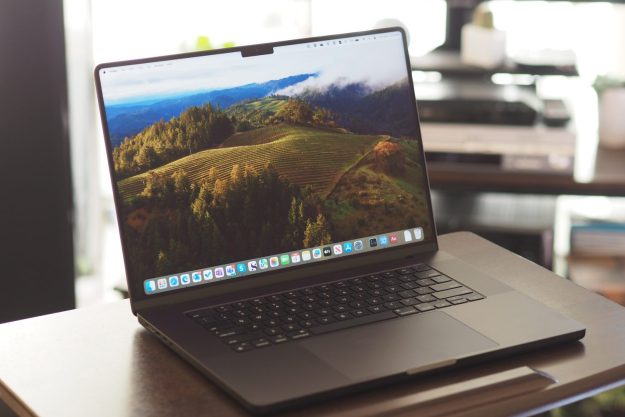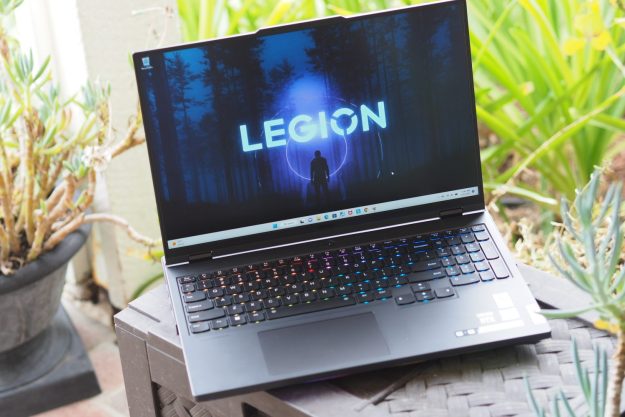
Also check out our full Motorola Atrix 4G review.
CES has been full of tablet PCs and 3D devices, but few of them really stand out or solve a problem. Will TV shows like The Office truly get more exciting with a foot of depth added to them? I’m not so sure. With the Atrix, however, Motorola has gone and invented a new product entirely, one that is both exciting and potentially useful.
The Atrix is really two devices: It’s a high-end dual-core 4G Android phone, and it’s a laptop computer. By snapping the phone into the back of a new laptop dock, it powers a full-size screen and keyboard with a modified Android (Linux) display made to resemble a desktop computer.
The Atrix phone

First, the phone. For a phone to also run a laptop, one needs some horsepower. From what we saw, the Atrix has some impressive specs. The Android 2.2 device is powered by Nvidia’s 1GHz Tegra 2 AP20H dual-core processor (one of the first dual-core phones) and has an impressive 1 GB of RAM, 16GB of internal memory, a powerful 1930 mAh battery, a 540×960 4-inch multitouch screen with gorilla glass (scratch and shatter resistant), a VGA front-facing camera, a 5MP rear camera that can record 720p video, and a proximity sensor for auto-turn-off.

The shot above shows another unique feature of the Atrix: it’s biometric fingerprint reader. The power button on the top rear of the unit doubles as the sensor, meaning that if someone that isn’t you tries to turn on your phone, it just won’t work. It would be a good security feature for those of you who (like me) tend to accidentally leave your phone in Las Vegas cabs when attending CES conventions.
The Atrix is also capable of 4G speeds, but is only being sold on AT&T in the United States, which may hurt its potential, considering the vitriol some have toward AT&T’s network and the success Motorola has had with its Android devices on Verizon Wireless. Verizon recently launched its own 4G network, but Motorola’s Atrix was not one of the 10 new 4G devices announced. The 4G Droid Bionic will launch on Verizon.
Becoming a laptop

Motorola has been pushing its docking solutions since the original Droid launched on Verizon more than a year ago. Like the original Droid, the Atrix will have have a Navigation dock for autos and a clock stand. However, the company is now introducing a new dock that effectively turns the Atrix into a thin laptop that resembles a Macbook Air. The peripheral is little more than a 15 (or so) inch screen and island-style keyboard with a built-in 8-10 hour battery. The phone connects via Micro USB and Micro HDMI connections on the side of the phone.



Using ‘Webtop’ mode
When docked into the rear of the laptop shell, the Atrix is charged by the dock and powers the device. Though the resolution seemed somewhat low, a split screen on the laptop shows the phone display and has space for some app shortcuts along the bottom (similar to Mac OS X) and app windows in the screen. Motorola is calling this the “Webtop” display mode. This form-factor is a Motorola modification of the standard Android OS, or may be powered separately by a Moto version of Linux. Our unit had shortcuts to a folder/directory navigator for browsing files, QuickOffice, and Mozilla Firefox. A big make-or-break for the Atrix will be how many other apps are available for the desktop client, how usable they are, and how easy they are to obtain. As it stands, the device appeared to be fairly competent as a Web browser and seemed good for most netbook-like light applications and uses.
Using the clock dock, the Atrix also has a desktop mode, for those hoping to plug the phone into a full monitor and keyboard (picture). The desktop version works identically to the laptop UI, from what we can tell.

Motorola representatives told us that when you undock your phone, it will suspend and hold all of your desktop apps and browser windows until you reconnect, making it possible to undock and redock without having to start your work over. If the phone is turned off between dockings, the apps will have to restart, but the Atrix will save your browser windows and docs before shutting off.

The unit also has some interesting multitasking features. Since the phone still has a window inside of the Webtop display, you can make calls using the speakerphone or a bluetooth headset, and do almost anything else you normally do on your phone. You can also open up Android apps and run them in full-screen. I’d imagine if the Atrix gets Android 3.0 (Honeycomb) at some point, most apps will already have a widescreen tablet display mode to them, making a unit like this all the more usable. With a button click, you can swap between open Webtop and phone applications on the fly (seen above).

No modern consumer product would be complete without a custom, odd looking media player, and the Atrix is no exception. A pretty looking series of domino-ish icons let you experience any pictures video, and music available on the device. We watched some sample videos on the device, which rendered quickly and looked great.
Are we ready?
The Atrix is a great first attempt at merging the worlds of PC and smartphones. Unlike tablets, which are better suited as consumption devices, the Atrix should appeal to those who still need or prefer a full keyboard and mouse to create content. With a built-in charger and long battery life, it will also be a great device for long flights and those on the go. The dock is fairly thin and well-built with what appears to be an aluminum shell and solid island-style keyboard.
The question is, will consumers embrace a new desktop interface? Though Android has taken off, the desktop world is still owned by Microsoft Windows and Mac OS X. Like Google Chrome, Motorola is attempting to introduce a new operating system into a very mature market. If applications aren’t easy to find and download and the platform isn’t open enough, it will likely be rejected after the “wow” factor wears off.

The other looming question is how much it will cost. If the phone already costs between $200 and $300 with a 2-year AT&T contract, how much will the extra dock cost? If it’s much more than $100, I can’t imagine it becoming a mainstream success. Low-end laptops and netbooks cost about $400 and up. If Motorola can’t beat or get close to that price, it’s hard to see many consumers choosing the Atrix as a desktop solution. There’s also the problem of bandwidth. It’s already easy to blow through AT&T’s $25 2GB data plan and with a full desktop client, many users will constantly encounter overages. Hopefully AT&T will address this and adapt plans, especially on its 4G network.
Still, the Atrix is my favorite new product out of CES so far. It has the potential to be a game-changing product and if it succeeds, we could see some very cool updates in the years to come. Hopefully Motorola will fully support the device.
CES Video
Below is a long 9 minute demo we got from a Motorola executive. I apologize about the length, but was too fascinated to stop recording. Fair warning, the audio is a bit faint and I am no professional photographer. Thanks to our own Greg Mombert for the photos seen above.



